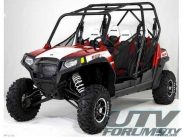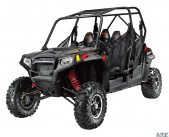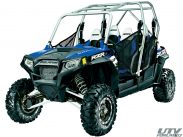The 2011 RANGER RZR® 4 Robby Gordon Edition is the world’s first 4-seat sport side-by-side. Built for extreme, Razor-Sharp Performance and agility in the dunes, desert and wide-open spaces. Key features are:
- 800 Twin-Cylinder High Output EFI Engine
- Fox Podium X® 2.0 Racing Shocks with Piggyback Reservoirs
- Maxxis® Bighorn® 26 in. Radial Tires With 12 in. Aluminum Rims
- Power And Agility For 4 The world’s first multipassenger sport side-by-side, and the industry’s only four-seat high-performance machine. Razor-sharp performance is now enjoyed by up to four people, and everyone gets a great view.
- New! Glove Box Storage Passenger-side glove box has 3 gallons of space for convenient, water-resistant storage.
- On-Demand True All-Wheel Drive (AWD) True AWD keeps you moving, automatically engaging all four wheels when you need more forward traction and reverting back to 2WD when you don’t.
- New! Redesigned Body Style The front end has new styling for an even more aggressive look when you’re riding on the trails. The redesign also increased the cooling airflow area by 29%.
- Long Travel Suspension Features a 60.5″ width, obstacle-clearing 11.5″ of ground clearance, and compression- and preload-adjustable suspensions to soak up deep ruts and deliver a smooth, precise ride every time. Plus it has the longest travel in the industry: 12″ front and 12″ rear.
- New ! Electronic Power Steering (EPS) The smoothest, most responsive electronic power steering available, with Variable Assist for easier steering at lower speeds and greater responsiveness at higher speeds. Our EPS lets you ride all day with less fatigue.
- 800 High-Output Twin EFI—Fastest Acceleration High-Output engine cranks out 53 hp and deliversthe fastest acceleration, from 0 to 35 mph in 4.4 seconds
- Comfortable Ergonomics Everyone rides in comfort, thanks to adjustable and interchangeable bucket seats, plus the adjustable front passenger handrail and full rear passenger handrail. Comfortable driver operation is enhanced by tilt steering with the highest range of motion (10″).
When Polaris introduced the RZR back in early 2007 it forever changed the benchmark for what we would expect from a side-by-side. Then in 2009 Polaris introduced the RZR S, a performance-oriented RZR that came right off of the dealer’s showroom floor with long travel A-arm suspension, Fox shocks, and 26” Maxxis Bighorn radials mounted on nice aluminum wheels. Now, for 2010 Polaris has lengthened the RZR S, making room for a second row of bucket seats to make the RZR 4, the first 4-seat performance side-by-side.If you are familiar with the RZR S then most of the features and specifications will be easily recognizable. So let’s start with what’s different. The standard RZR frame has been lengthened a whopping 26 inches taking the wheelbase to 103 inches! The frame has also been strengthened in the process to handle the added stress that the added length creates
Directly behind the front pair of buckets are an additional set of identical seats. Just like the front set, the rear seats are adjustable fore and aft. Although not quite as easy as a sliding lever like you find on your
car, you can pull the seat from the RZR and by loosening four torx-head screws you can slide the seat forward or back. And there’s enough adjustment to provide a comfortable seating position for just about everyone. Also helping in that department is the tilt wheel. Simply pull the lever and a hydraulic shock allows the wheel to tilt up for easy egress and seating for the big and tall group, and down for easy reach by those of us in the category of short and thin. And while we’re discussing the steering wheel, it has a pair of bulges at 10 and 2 o’clock that help make it comfortable to grip, even in tough going
The dash layout and gauges remain the same with a large dial speedometer with the odometer, trip odometer, hour meter, tachometer, clock, fuel gauge, and drive position all located inside the face. On the dash are the switches for the headlights and the all wheel drive system, along with a 12-volt accessory plug. On the passenger’s side you’ll find the same great adjustable t-handle that’s typically found only in race buggies and sand cars.
Thanks in part to the RZR S, Polaris had already strengthened the frame around the front and rear suspension points as well as the rear suspension and shock mounts to better withstand the stress applied from adding the long travel arms. The front and rear suspension on the RZR 4 uses the same set-up as the RZR S with dual A-arms with five-way preload adjustable Fox Podium shocks at each corner with 12 inches of suspension travel. The ground clearance is 12 inches with 26-inch Maxxis Bighorn radial tires mounted on 12-inch aluminum wheels. And the brakes are discs at each corner.
Powering the new RZR 4 is the same liquid-cooled, fuel injected 760cc twin cylinder H.O. engine as in the S model, putting out 55 horsepower and propelling the RZR to a top speed of 61 mph. The transmission is the same CVT unit found in the other RZRs that has Park at the forward position, Reverse one notch back, then neutral in the center, with the low range one more notch back and high all the way to the rear.
The RZR 4 has a dry weight of 1,255 pounds. The carrying capacity and tow rating are the same as the two-seat RZR. It can carry 300 pounds in its 42-inch by 22-inch bed and 2-seaters and is rated to tow 1,500 pounds using the slide-in hitch receiver system. The bed is also equipped with Polaris’ unique Lock & Ride cargo latching system.
But enough information and details, let’s see how this thing works!
First and foremost there is just no getting around how long the RZR 4 is — and feels, especially on those really tight and twisty trails. But maybe mostly any time you need to either turn it around or back it up. I almost expect to hear one of those construction-style beepers go off every time I snick the transmission into reverse. But that length does have some benefits that can offset the negatives. For one, the added length makes the 4 handle almost scarily good in the rough terrain – especially whooped trails. I say scarily because I think that this thing handles so incredible that by the time you find yourself running out of talent, you’re gonna be in really big trouble. But then 103 inches of wheelbase, 60 inches of width, and 12 inches of well-damped travel will do that.
Those ingredients also help to make the ride incredibly cushy soft as well. Plus, the adjustability of the rear shocks make it possible to adjust the weight balance whether you’re running two lightweight passengers, or four heavyweight ones. And one other benefit of the longer wheelbase is that the engine is moved farther behind the driver, making for a much quieter ride – at least for the two people up front!
Whether you’re racing through fast sweepers or trying to make a five-point turn on a tight trail, the steering is easy enough that there’s no real need for the addition of power steering. We also found that on those faster sweepers that the steering is very accurate in its operation. That’s most likely the result of a well-balanced chassis and those Maxxis radial tires. And even with the longer wheelbase you can still control the direction that the front end points while powering around a corner with the use of the throttle.
Like all RZRs, the shifter is still far too notchy and you have to be very, very careful not to grind the gears when shifting from forward to reverse. Shifting the RZR makes looking like you rented it for the day all too easy. And, like we’ve said about every RZR we’ve tested since they were first introduced, it really, really needs a mechanical parking brake! The engine braking needs to be better as well, and that means less noticeable not more powerful
The RZR has a bad habit of hopping down the more treacherous downhills in a slightly confused state, sometimes thinking it should bind up the belt and apply full braking (to the rear wheels only) and at other times just throwing it’s hands up in the air and letting the RZR fly, releasing all the braking as the belt spins freely. Strangely enough, at those times, and against your better judgment, the procedure is to apply the throttle, at which time the RZR will lurch back into full rear wheel only braking mode. It’s never pretty and we hope that someday Polaris will find a way to remedy that.So even with all that negative stuff said, I’ll be out cruising the trails in the RZR 4. Because if you can find a better and more comfortable way for four people to explore the backcountry trails and shoot through the sand dunes for this price, let me know. And until then, I’ll be spending time with my family and friends exploring the back country in the RZR 4






No Comments
Trackbacks/Pingbacks